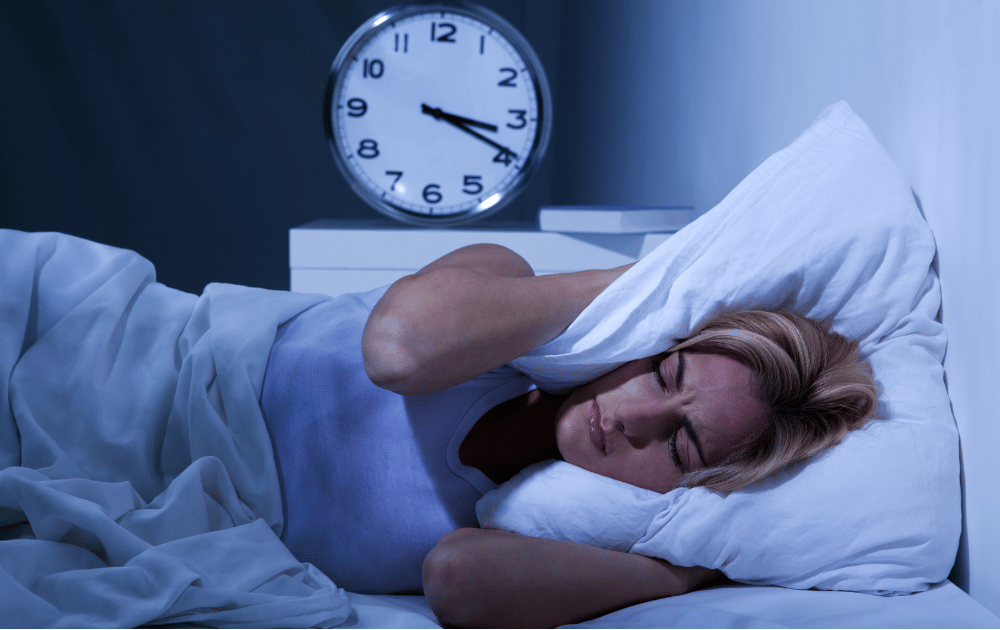I turned 50 last year, and I can definitively say I’ve been in perimenopause for the last few years. The symptoms haven’t been extreme (yet). But I went through several months where I had periods every three weeks. And for the last year or so, I never know when I’m going to have one. I’ll go four months and think, “This is it. I’m done with periods now. Hooray!” Then it will randomly decide to show up one day.
My mood swings have been pretty dramatic, but just being aware has helped me manage that. As I start to get teary-eyed over something menial, I’ll think to myself, “your hormones are out of whack” and that’s enough to pull me out of it (usually).
I also deal with middle-of-the-night insomnia and hot flashes. Do any of you play the game where you throw off the sheets & comforter, then you get cold and bring the sheets back, then you’re still cold so you bring the comforter back, then you’re hot again? No? Just me?
Whenever I think about hot flashes, I’m reminded of a funny story about one of my sons when he was about four years old. We were leaving my mom’s house, and she always had a mini fan at the ready for her frequent hot flashes. It was a hot summer day, and I got the kids strapped into their car seats in the back of my minivan. My son had a toy mini fan he got at an amusement park, and he was blowing it on his face and making exasperated noises. I asked, “What are you doing?” And he replied, “Ugh! I’m having a hot flash!”
Hot flashes, insomnia, irregular periods – with all this hormonal upheaval, I can’t help but wonder, “when will it end?” So, let’s explore perimenopause, the symptoms, and signs that it’s ending.
What is perimenopause?
Simply put, perimenopause means “around menopause” in which you start to show symptoms of transitioning to menopause, but you haven’t gone a full 12 months with no period. During this time, our estrogen levels rise and fall causing our menstrual cycle to become irregular.
When does perimenopause start?
Perimenopause typically starts when we’re in our 40s but could start as early as our mid-30s. The most common age range for women to enter perimenopause is ages 40 to 44. However, menopause can also start prematurely if a woman has had a hysterectomy.
If she has a full hysterectomy, which includes the removal of the uterus and both ovaries, she immediately goes into menopause because her periods stop, and she no longer has ovaries producing estrogen. If she has a partial hysterectomy, meaning one or both ovaries remain, then her periods stop but her ovaries may still produce estrogen, so she’s not experiencing the other symptoms of menopause such as hot flashes and insomnia.
What are the symptoms of perimenopause?
Irregular menstrual cycle
The primary indicator that you’re entering perimenopause is irregular periods. They may come more frequently or less frequently than your normal cycle. Additionally, they may be much heavier than usual or lighter. They may also be longer or shorter in duration. It is common to skip a cycle or a few cycles. And, just to keep things interesting, it will change from period to period. You might start having them more frequently and heavier for a few months, then have them less frequently and lighter for a few months.
Hot flashes
In case you ever get asked in a game of trivia, the scientific name for hot flashes is vasomotor symptoms. And despite being studied for over 30 years, science has not determined why or how they occur. Hot flashes are correlated to estrogen, which is why estrogen therapies work so well in mitigating them. However, researchers have found no difference in the level of estrogen in women who have hot flashes and those who don’t.
As many as half of women in perimenopause experience hot flashes. These sudden waves of body heat typically last 5-10 minutes. They are most likely to occur at night but can also happen during the day. Hot flashes vary in intensity from woman to woman, and some women report not experiencing them at all.
In most cases, hot flashes continue to occur for 3 to 5 years although some women report them continuing for years after menopause.

Insomnia
It’s unclear whether changes in hormones cause sleep problems in perimenopausal women. Hot flashes during the night can be one factor. But also, sleep cycles change as we age, and insomnia becomes a common age-related problem among both women and men.
New life stressors may also contribute to insomnia at this stage of our lives. If you have children, you may be entering the “empty nester” phase. This can cause anxiety and sadness because you miss them being at home. But can also leave you with an uneasy sense of “what now?” I personally spent so much of my 30s and 40s attending ball games, choir concerts, taekwondo tournaments, band competitions, and school functions that I barely had a social life and didn’t even think about hobbies. With two of my three kids now in college, and the third not far behind, I’m in this odd place of trying to figure out what I want to be when I grow up. I’m signing up for new volunteer opportunities, trying out new hobbies, and spending more time with friends.
Whether it’s hormones, night sweats, age, or stress, insomnia is an annoying symptom and 40% of perimenopausal women report suffering from it.
Vaginal dryness
In late perimenopause, a drop in estrogen can cause vaginal tissue to become thinner and drier. This can cause irritation and make intercourse painful. Unfortunately, it often becomes worse in menopause than in perimenopause.
Mood changes
Changes in hormones are one factor affecting our moods in perimenopause. But lack of sleep due to hot flashes in the night can also contribute to our mood swings. Some women develop clinical depression during this time, but it usually goes away within a few years after menopause. Your likelihood of mood swings and depression is greater if you experienced similar symptoms with PMS in your earlier years.
Similar to new life stressors impacting your sleep, they can also contribute to your mood changes. These include kids leaving the nest, anticipating retirement, and any age-related health issues.
Headaches
Big fluctuations in hormones can lead to headaches. If you have a history of migraines, these can become more frequent and severe during perimenopause due to those fluctuations. Fortunately, these tend to improve once you’re in menopause, but tension headaches could worsen at that time.
Signs perimenopause is ending
In general, the symptoms outlined above are lighter in early perimenopause and more extreme as you’re nearing the end due to a dramatic drop in estrogen.
You are officially at the end of perimenopause and in menopause once you’ve gone 12 months without a period. Signs that perimenopause is ending include more time between periods, fewer mood swings, more frequent hot flashes, less sleep, and fewer headaches.
Let’s explore each of these in more detail.
More time between periods
In early perimenopause, you may have periods more frequently or miss a month or two. As you get closer to menopause, more time passes between periods. Once you’ve gone 12 months without a period, you are in menopause. It is not normal to have a period after this time. If you experience any bleeding after menopause, please consult your doctor.
Mood stabilizes
In perimenopause, your estrogen fluctuates contributing to mood swings. As you get closer to menopause, your estrogen is still low but is more stable, which helps stabilize your mood.
More frequent hot flashes
Many women think of hot flashes occurring in menopause. But they actually start in late perimenopause and can continue for a few years into menopause. If you notice your hot flashes becoming more frequent, it could be a sign that you’re nearing the end of perimenopause.
Less sleep
With more frequent hot flashes comes less sleep. Since hot flashes are more likely to occur at night, they become very disruptive to our sleep cycle. This occurs more often near the end of perimenopause, indicating that we’re getting closer to menopause.
Vaginal dryness
Earlier, I pointed out that vaginal dryness is a common symptom of perimenopause. You may notice no difference at all in early perimenopause. It occurs more in late perimenopause, so if you’re experiencing this symptom, you may be nearing the end of the perimenopause stage.
Summary
Perimenopause is the transition from your reproductive years into your non-reproductive years or menopause. You may experience many inconvenient, if not disruptive, symptoms like irregular periods, hot flashes, insomnia, and mood swings. These tend to get worse as you get closer to menopause. Signs that perimenopause is ending include longer intervals of time between periods, more hot flashes, more bouts of insomnia, and vaginal dryness. Once you’ve gone 12 months without a period, you are officially done with perimenopause and in menopause. One of the best ways to get through this difficult stage in life is to connect with women who are going through it too. If you don’t have a group of friends at this stage that you can talk to, here are some other resources to turn to:





Great post, Nikkie! I can definitely relate to the symptoms of perimenopause and the uncertainty of when it will end. I found your explanation of perimenopause and its symptoms very informative and helpful. I also appreciated your personal anecdotes and the touch of humor you added to the post. It made it relatable and easy to read. Thanks for sharing your experiences and insights; it’s always comforting to know that others are going through similar things. I appreciate the tips and suggestions you provided for the symptoms.
Thanks, Winfred. I’m glad you found the information helpful. My hope is to create a community of women going through a similar stage in life so we can share experiences, information, and tips for dealing with the symptoms.